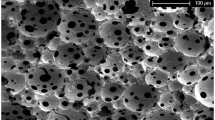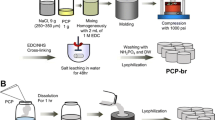Abstract
In this study, three-dimensional (3D) porous scaffolds were developed for the repair of articular cartilage defects. Novel collagen/polylactide (PLA), chitosan/PLA, and collagen/chitosan/PLA hybrid scaffolds were fabricated by combining freeze-dried natural components and synthetic PLA mesh, where the 3D PLA mesh gives mechanical strength, and the natural polymers, collagen and/or chitosan, mimic the natural cartilage tissue environment of chondrocytes. In total, eight scaffold types were studied: four hybrid structures containing collagen and/or chitosan with PLA, and four parallel plain scaffolds with only collagen and/or chitosan. The potential of these types of scaffolds for cartilage tissue engineering applications were determined by the analysis of the microstructure, water uptake, mechanical strength, and the viability and attachment of adult bovine chondrocytes to the scaffolds. The manufacturing method used was found to be applicable for the manufacturing of hybrid scaffolds with highly porous 3D structures. All the hybrid scaffolds showed a highly porous structure with open pores throughout the scaffold. Collagen was found to bind water inside the structure in all collagen-containing scaffolds better than the chitosan-containing scaffolds, and the plain collagen scaffolds had the highest water absorption. The stiffness of the scaffold was improved by the hybrid structure compared to plain scaffolds. The cell viability and attachment was good in all scaffolds, however, the collagen hybrid scaffolds showed the best penetration of cells into the scaffold. Our results show that from the studied scaffolds the collagen/PLA hybrids are the most promising scaffolds from this group for cartilage tissue engineering.





Similar content being viewed by others
References
Kinner B, Capita RM, Spector M. Regeneration of articular cartilage. Adv Biochem Eng Biotechnol. 2005;4:91–123.
Hunziker EB. Articular cartilage repair: basic science and clinical progress. A review of the current status and prospects. Osteoarthr Cartil. 2002;10:432–63.
Moutos FT, Guilak F. Composite scaffolds for cartilage tissue engineering. Biorheology. 2008;45:501–12.
Chung C, Burdick JA. Engineering cartilage tissue. Adv Drug Deliv Rev. 2008;60:243–62.
Risbud MV, Sittinger M. Tissue engineering: advances in in vitro cartilage generation. Trends Biotechnol. 2002;20:351–6.
Ge Z, Li C, Heng BC, Cao G, Yang Z. Functional biomaterials for cartilage regeneration. J Biomed Mater Res A. 2012;100(9):2526–36.
Ahmed TAE, Hincke MT. Strategies for articular cartilage lesion repair and functional restoration. Tissue Eng Part B. 2010;16:305–29.
Kalson NS, Gikas PD, Briggs TWR. Current strategies for knee cartilage repair. Int J Clin Pract. 2010;64:1444–52.
Peterson L, Vasiliadis HS, Brittberg M, Lindahl A. Autologous chondrocyte implantation: a long-term follow-up. Am J Sports Med. 2010;38:1117–24.
Vinatier C, Mrugala D, Jorgensen C, Guicheux J, Noël D. Cartilage engineering: a crucial combination of cells, biomaterials and biofactors. Trends Biotechnol. 2009;27:307–14.
Kock L, Van Donkelaar CC, Ito K. Tissue engineering of functional articular cartilage: the current status. Cell Tissue Res. 2012;347:613–27.
Iwasa J, Engebretsen L, Shima Y, Ochi M. Clinical application of scaffolds for cartilage tissue engineering. Knee Surg Sports Traumatol Arthrosc. 2009;17:561–77.
Kim IY, Seo SJ, Moon HS, Yoo MK, Park IY, Kim BC, Cho CS. Chitosan and its derivatives for tissue engineering applications. Biotechnol Adv. 2008;26:1–21.
Francis Suh JK, Matthew HWT. Application of chitosan-based polysaccharide biomaterials in cartilage tissue engineering: a review. Biomaterials. 2000;21:2589–98.
Chen G, Ushida T, Tateishi T. Scaffold design for tissue engineering. Macromol Biosci. 2002;2:67–77.
Chen G, Sato T, Ushida T, Hirochika R, Shirasaki Y, Ochiai N, Tateishi T. The use of a novel PLGA fiber/collagen composite web as a scaffold for engineering of articular cartilage tissue with adjustable thickness. J Biomed Mater Res A. 2003;67:1170–80.
Dai W, Kawazoe N, Lin X, Dong J, Chen G. The influence of structural design of PLGA/collagen hybrid scaffolds in cartilage tissue engineering. Biomaterials. 2010;31:2141–52.
Sato T, Chen G, Ushida T, Ishii T, Ochiai N, Tateishi T. Tissue-engineered cartilage by in vivo culturing of chondrocytes in PLGA–collagen hybrid sponge. Mater Sci Eng C. 2001;17:83–9.
Chen G, Sato T, Ushida T, Ochiai N, Tateishi T. Tissue engineering of cartilage using a hybrid scaffold of synthetic polymer and collagen. Tissue Eng. 2004;10:323–30.
Haaparanta AM, Koivurinta J, Hämäläinen ER, Kellomäki M. The effect of cross-linking time on a porous freeze-dried collagen scaffold using 1-ethyl-3-(3-dimethylaminopropyl)carbodiimide as a cross-linker. J Appl Biomater Biomech. 2008;6:89–94.
Davidenko N, Campbell JJ, Thian ES, Watson CJ, Cameron RE. Collagen–hyaluronic acid scaffolds for adipose tissue engineering. Acta Biomater. 2010;6:3957–68.
Pulkkinen HJ, Tiitu V, Valonen P, Jurvelin JS, Lammi MJ, Kiviranta I. Engineering of cartilage in recombinant human type II collagen gel in nude mouse model in vivo. Osteoarthr Cartil. 2010;18:1077–87.
Harley BA, Leung JH, Silva ECCM, Gibson LJ. Mechanical characterization of collagen–glycosaminoglycan scaffolds. Acta Biomater. 2007;3:463–74.
Pulliainen O, Vasara AI, Hyttinen MM, Tiitu V, Valonen P, Kellomäki M, Jurvelin JS, Peterson L, Lindahl A, Kiviranta I, Lammi MJ. Poly-l-d-lactic acid scaffold in the repair of porcine knee cartilage lesions. Tissue Eng. 2007;13:1347–55.
Parsons JR. Cartilage. In: Black J, Hastings, G editors. Handbook of biomaterial properties. 1998. pp. 40–46.
Castro NJ, Hacking SA, Zhang LG. Recent progress in interfacial tissue engineering approaches for osteochondral defects. Ann Biomed Eng. 2012;40:1628–40.
Acknowledgments
We would like to thank Antti Aula for microCT image editing. The financial support of the Finnish Funding Agency for Technology and Innovation (TEKES) is greatly appreciated (Grant 3110/31/08).
Author information
Authors and Affiliations
Corresponding author
Rights and permissions
About this article
Cite this article
Haaparanta, AM., Järvinen, E., Cengiz, I.F. et al. Preparation and characterization of collagen/PLA, chitosan/PLA, and collagen/chitosan/PLA hybrid scaffolds for cartilage tissue engineering. J Mater Sci: Mater Med 25, 1129–1136 (2014). https://doi.org/10.1007/s10856-013-5129-5
Received:
Accepted:
Published:
Issue Date:
DOI: https://doi.org/10.1007/s10856-013-5129-5




